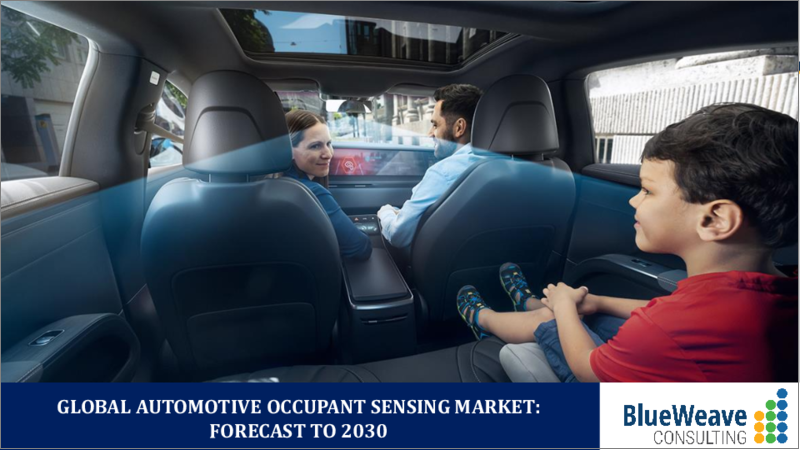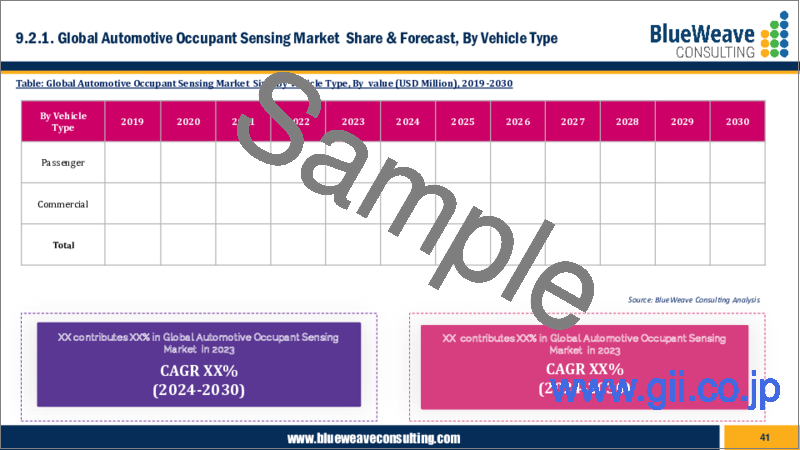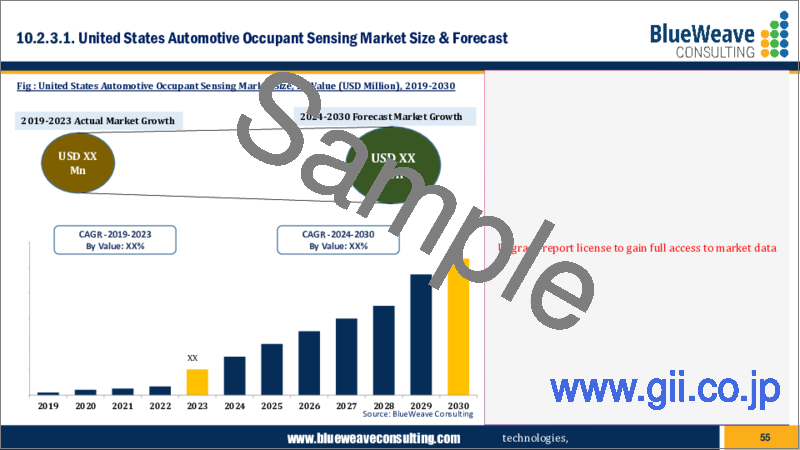|
|
市場調査レポート
商品コード
1301786
自動車用乗員検知システム市場:世界の市場規模、シェア、動向分析、機会、予測レポート、2019-2029年Automotive Occupant Sensing Market - Global Size, Share, Trend Analysis, Opportunity and Forecast Report, 2019-2029, Segmented By Type ; By Vehicle Type ; By Channel ; By Region |
||||||
|
|||||||
| 自動車用乗員検知システム市場:世界の市場規模、シェア、動向分析、機会、予測レポート、2019-2029年 |
|
出版日: 2023年06月19日
発行: Blueweave Consulting
ページ情報: 英文 400 Pages
納期: 2~3営業日
|
- 全表示
- 概要
- 目次
自動車用乗員検知システムの世界市場規模はCAGR 7.03%で安定成長、2029年には67億2,000万米ドルに達する見込み
自動車の高度な安全機能に対する需要の増加、乗員保護に関する意識の高まり、乗員の安全性に関する政府の厳しい規制などにより、世界の自動車用乗員検知システム市場は急速に成長しています。
戦略コンサルティング・市場調査の大手であるBlueWeave Consultingは、最近の調査で、2022年の自動車用乗員検知システムの世界市場規模を42億2,000万米ドルと推定しました。2023年から2029年の予測期間中、自動車用乗員検知システムの世界市場規模はCAGR 7.03%で堅調に成長し、2029年には67億2,000万米ドルに達する見込みです。近年、世界の自動車用乗員検知システム産業には大きな変化が見られます。自動車における最先端の安全対策へのニーズの高まりは、顕著な動向の1つです。重量センサー、圧力センサー、シートベルトセンサーなどの乗員検知システムを自動車に組み込むことで、自動車メーカーは乗員の安全性を重視しています。乗員の体格、位置、体重に基づいてエアバッグをより効率的に展開するインテリジェントエアバッグシステムの使用も、普及が進む動向のひとつです。また、人間の乗員だけでなく、車内に残されたペットのような物体も識別できる乗員検知システムの開発にも重点が置かれるようになっており、安全性が向上し、事故の可能性が低下しています。
本レポートの詳細分析では、世界の自動車用乗員検知システム市場の成長可能性、今後の動向、統計に関する情報を提供しています。また、総市場規模の予測を促進する要因も取り上げています。当レポートは、自動車用乗員センサーの世界市場における最新の技術動向や、意思決定者が戦略的な意思決定を行う際に役立つ業界インサイトを提供することをお約束します。さらに、市場の成長促進要因・課題・競争力についても分析しています。
目次
第1章 調査の枠組み
第2章 エグゼクティブサマリー
第3章 世界の自動車用乗員検知システム市場に関する洞察
- 業界のバリューチェーン分析
- DROC分析
- 成長の原動力
- 乗客の安全への関心の高まり
- 高度な安全機能に対する消費者の意識と需要の高まり
- 抑制要因
- 導入コストが高い
- 機会
- テクノロジーの進歩
- 課題
- 標準化された規制の欠如
- 成長の原動力
- 技術の進歩/最近の開発
- 規制の枠組み
- ポーターのファイブフォース分析
第4章 世界の自動車用乗員検知システム市場概要
- 市場規模と予測、2019~2029年
- 金額別
- 市場シェアと予測
- タイプ別
- カメラ
- ひずみゲージ
- 圧力マット
- 超音波センサー
- 車種別
- 乗用車
- 商用車
- チャネル別
- OEM
- アフターマーケット
- 地域別
- 北米
- 欧州
- アジア太平洋(APAC)
- ラテンアメリカ(LATAM)
- 中東およびアフリカ(MEA)
- タイプ別
第5章 北米の自動車用乗員検知システム市場
- 市場規模と予測、2019~2029年
- 金額別
- 市場シェアと予測
- タイプ別
- 車種別
- チャネル別
- 国別
- 米国
- カナダ
第6章 欧州の自動車用乗員検知システム市場
- 市場規模と予測、2019~2029年
- 金額別
- 市場シェアと予測
- タイプ別
- 車種別
- チャネル別
- 国別
- ドイツ
- 英国
- イタリア
- フランス
- スペイン
- ベルギー
- ロシア
- オランダ
- その他欧州
第7章 アジア太平洋地域の自動車用乗員検知システム市場
- 市場規模と予測、2019~2029年
- 金額別
- 市場シェアと予測
- タイプ別
- 車種別
- チャネル別
- 国別
- 中国
- インド
- 日本
- 韓国
- オーストラリアとニュージーランド
- インドネシア
- マレーシア
- シンガポール
- ベトナム
- APACのその他諸国
第8章 ラテンアメリカの自動車用乗員検知システム市場
- 市場規模と予測、2019~2029年
- 金額別
- 市場シェアと予測
- タイプ別
- 車種別
- チャネル別
- 国別
- ブラジル
- メキシコ
- アルゼンチン
- ペルー
- 中南米の残りの地域
第9章 中東およびアフリカの自動車用乗員検知システム市場
- 市場規模と予測、2019~2029年
- 金額別
- 市場シェアと予測
- タイプ別
- 車種別
- チャネル別
- 国別
- サウジアラビア
- アラブ首長国連邦
- カタール
- クウェート
- 南アフリカ
- ナイジェリア
- アルジェリア
- MEAの残りの部分
第10章 競合情勢
- 主要企業とその製品のリスト
- 世界の自動車用乗員検知システム企業の市場シェア分析、2022年
- 動作パラメータによる競合ベンチマーキング
- 主要な戦略的展開(合併、買収、パートナーシップなど)
第11章 世界の自動車用乗員検知システム市場に対するCOVID-19の影響
第12章 企業プロファイル(会社概要、財務マトリックス、競合情勢、主要な人材、主要な競合、連絡先住所、戦略的展望、 SWOT分析)
- Takata Corporation
- Autoliv Inc.
- Robert Bosch
- Continental AG
- Delphi Automotive PLC
- Hyundai Mobis Co., Ltd.
- Key Safety Systems Inc.
- Lear Corporation
- ZF Friedrichshafen AG
- Volvo
- Other Prominent Players
第13章 主要な戦略的推奨事項
第14章 調査手法
Global Automotive Occupant Sensing Market Size Set to Grow at Steady CAGR of 7.03% to Reach USD 6.72 by 2029
Global automotive occupant sensing market is rapidly growing due to increasing demand for advanced safety features in vehicles, growing awareness regarding occupant protection, and stringent government regulations for passenger safety.
BlueWeave Consulting, a leading strategic consulting and market research firm, in its recent study, estimated global automotive occupant sensing market size at USD 4.22 billion in 2022. During the forecast period between 2023 and 2029, global automotive occupant sensing market size is to grow at a robust CAGR of 7.03% reaching a value of USD 6.72 billion by 2029. Significant changes have been observed in the global automotive occupant sensing industry in recent years. The rising need for cutting-edge safety measures in cars is one noticeable trend. By incorporating occupant sensing systems, such as weight sensors, pressure sensors, and seatbelt sensors, into their vehicles, automakers are placing a higher priority on passenger safety. The usage of intelligent airbag systems, which deploy airbags more efficiently based on the size, position, and weight of the occupants, is another trend that is becoming more prevalent. Also, there is a growing emphasis on creating occupant sensing systems that can identify not just human occupants but also objects like pets left inside the car, improving safety and lowering the likelihood of accidents.
Global Automotive Occupant Sensing Market - Overview:
The technologies and systems used in vehicles to detect the presence, position, and characteristics of occupants within the vehicle's interior are referred to as automotive occupant sensing. To identify the number of occupants, their size, weight, and seating postures, these systems typically use a mix of sensors and algorithms. The major goal of automobile occupant sensing is to improve safety by allowing correct deployment and control of vehicle restraint devices like airbags. The system may adjust the deployment of airbags, seat belt pre-tensioners, and other safety elements to provide optimal protection during a crash or sudden maneuver while minimizing the risk of injury to occupants by properly identifying the occupants and their traits.
Impact of COVID-19 on Global Automotive Occupant Sensing Market
The global automotive occupant sensing market experienced significant disruptions due to the COVID-19 pandemic. As governments implemented stringent lockdown measures and restricted mobility, automotive production, and sales faced a sharp decline, negatively impacting the demand for occupant sensing technologies. With reduced consumer spending and financial uncertainties, the automotive industry witnessed a slowdown, leading to deferred investments in advanced safety systems. Also, supply chain disruptions and manufacturing halts hampered the production and distribution of occupant sensing components, affecting the market's growth. However, as the world gradually recovers from the pandemic, the market is expected to regain momentum as the automotive industry rebounds and prioritizes safety technologies.
Global Automotive Occupant Sensing Market - By Type:
On the basis of type, the global automotive occupant sensing market is divided into Cameras, Strain Gauges, Pressure Mats, and Ultrasonic Sensors. The largest segment is cameras. Cameras are widely used for occupant sensing due to their versatility, accuracy, and ability to capture real-time data. They can detect and track occupants' movements, gestures, and positions, enabling advanced safety features such as seatbelt reminders, airbag deployment optimization, and driver monitoring systems. While other technologies like strain gauges, pressure mats, and ultrasonic sensors also play a significant role, cameras dominate the market with their advanced capabilities and widespread adoption in modern vehicles.
Competitive Landscape:
Global automotive occupant sensing market is fiercely competitive. Major companies in the market include Takata Corporation, Autoliv Inc., Robert Bosch, Continental AG, Delphi Automotive PLC, Hyundai Mobis Co., Ltd., Key Safety Systems Inc., Lear Corporation, ZF Friedrichshafen AG, and Volvo. Companies use various strategies, including increasing investments in their R&D activities, mergers, and acquisitions, joint ventures, collaborations, licensing agreements, and new product and service releases to further strengthen their position in global automotive occupant sensing market.
The in-depth analysis of the report provides information about growth potential, upcoming trends, and statistics of Global Automotive Occupant Sensing Market. It also highlights the factors driving forecasts of total market size. The report promises to provide recent technology trends in Global Automotive Occupant Sensing Market and industry insights to help decision-makers make sound strategic decisions. Furthermore, the report also analyzes the growth drivers, challenges, and competitive dynamics of the market.
Table of Contents
1. Research Framework
- 1.1. Research Objective
- 1.2. Product Overview
- 1.3. Market Segmentation
2. Executive Summary
3. Global Automotive Occupant Sensing System Market Insights
- 3.1. Industry Value Chain Analysis
- 3.2. DROC Analysis
- 3.2.1. Growth Drivers
- 3.2.1.1. Increasing focus on passenger safety
- 3.2.1.2. Rising consumer awareness and demand for advanced safety features
- 3.2.2. Restraints
- 3.2.2.1. High cost of implementation
- 3.2.3. Opportunities
- 3.2.3.1. Advancement in Technology
- 3.2.4. Challenges
- 3.2.4.1. Lack of standardized regulations
- 3.2.1. Growth Drivers
- 3.3. Technology Advancements/Recent Developments
- 3.4. Regulatory Framework
- 3.5. Porter's Five Forces Analysis
- 3.5.1. Bargaining Power of Suppliers
- 3.5.2. Bargaining Power of Buyers
- 3.5.3. Threat of New Entrants
- 3.5.4. Threat of Substitutes
- 3.5.5. Intensity of Rivalry
4. Global Automotive Occupant Sensing System Market Overview
- 4.1. Market Size & Forecast, 2019-2029
- 4.1.1. By Value (USD Million)
- 4.2. Market Share & Forecast
- 4.2.1. By Type
- 4.2.1.1. Cameras
- 4.2.1.2. Strain Gauges
- 4.2.1.3. Pressure Mats
- 4.2.1.4. Ultrasonic Sensors
- 4.2.2. By Vehicle Type
- 4.2.2.1. Passenger
- 4.2.2.2. Commercial
- 4.2.3. By Channel
- 4.2.3.1. Original equipment Manufacturers
- 4.2.3.2. Aftermarket
- 4.2.4. By Region
- 4.2.4.1. North America
- 4.2.4.2. Europe
- 4.2.4.3. Asia Pacific (APAC)
- 4.2.4.4. Latin America (LATAM)
- 4.2.4.5. Middle East and Africa (MEA)
- 4.2.1. By Type
5. North America Automotive Occupant Sensing System Market
- 5.1. Market Size & Forecast, 2019-2029
- 5.1.1. By Value (USD Million)
- 5.2. Market Share & Forecast
- 5.2.1. By Type
- 5.2.2. By Vehicle Type
- 5.2.3. By Channel
- 5.2.4. By Country
- 5.2.4.1. United States
- 5.2.4.1.1. By Type
- 5.2.4.1.2. By Vehicle Type
- 5.2.4.1.3. By Channel
- 5.2.4.2. Canada
- 5.2.4.2.1. By Type
- 5.2.4.2.2. By Vehicle Type
- 5.2.4.2.3. By Channel
6. Europe Automotive Occupant Sensing System Market
- 6.1. Market Size & Forecast, 2019-2029
- 6.1.1. By Value (USD Million)
- 6.2. Market Share & Forecast
- 6.2.1. By Type
- 6.2.2. By Vehicle Type
- 6.2.3. By Channel
- 6.2.4. By Country
- 6.2.4.1. Germany
- 6.2.4.1.1. By Type
- 6.2.4.1.2. By Vehicle Type
- 6.2.4.1.3. By Channel
- 6.2.4.2. United Kingdom
- 6.2.4.2.1. By Type
- 6.2.4.2.2. By Vehicle Type
- 6.2.4.2.3. By Channel
- 6.2.4.3. Italy
- 6.2.4.3.1. By Type
- 6.2.4.3.2. By Vehicle Type
- 6.2.4.3.3. By Channel
- 6.2.4.4. France
- 6.2.4.4.1. By Type
- 6.2.4.4.2. By Vehicle Type
- 6.2.4.4.3. By Channel
- 6.2.4.5. Spain
- 6.2.4.5.1. By Type
- 6.2.4.5.2. By Vehicle Type
- 6.2.4.5.3. By Channel
- 6.2.4.6. Belgium
- 6.2.4.6.1. By Type
- 6.2.4.6.2. By Vehicle Type
- 6.2.4.6.3. By Channel
- 6.2.4.7. Russia
- 6.2.4.7.1. By Type
- 6.2.4.7.2. By Vehicle Type
- 6.2.4.7.3. By Channel
- 6.2.4.8. Netherlands
- 6.2.4.8.1. By Type
- 6.2.4.8.2. By Vehicle Type
- 6.2.4.8.3. By Channel
- 6.2.4.9. Rest of Europe
- 6.2.4.9.1. By Type
- 6.2.4.9.2. By Vehicle Type
- 6.2.4.9.3. By Channel
7. Asia Pacific Automotive Occupant Sensing System Market
- 7.1. Market Size & Forecast, 2019-2029
- 7.1.1. By Value (USD Million)
- 7.2. Market Share & Forecast
- 7.2.1. By Type
- 7.2.2. By Vehicle Type
- 7.2.3. By Channel
- 7.2.4. By Country
- 7.2.4.1. China
- 7.2.4.1.1. By Type
- 7.2.4.1.2. By Vehicle Type
- 7.2.4.1.3. By Channel
- 7.2.4.2. India
- 7.2.4.2.1. By Type
- 7.2.4.2.2. By Vehicle Type
- 7.2.4.2.3. By Channel
- 7.2.4.3. Japan
- 7.2.4.3.1. By Type
- 7.2.4.3.2. By Vehicle Type
- 7.2.4.3.3. By Channel
- 7.2.4.4. South Korea
- 7.2.4.4.1. By Type
- 7.2.4.4.2. By Vehicle Type
- 7.2.4.4.3. By Channel
- 7.2.4.5. Australia & New Zealand
- 7.2.4.5.1. By Type
- 7.2.4.5.2. By Vehicle Type
- 7.2.4.5.3. By Channel
- 7.2.4.6. Indonesia
- 7.2.4.6.1. By Type
- 7.2.4.6.2. By Vehicle Type
- 7.2.4.6.3. By Channel
- 7.2.4.7. Malaysia
- 7.2.4.7.1. By Type
- 7.2.4.7.2. By Vehicle Type
- 7.2.4.7.3. By Channel
- 7.2.4.8. Singapore
- 7.2.4.8.1. By Type
- 7.2.4.8.2. By Vehicle Type
- 7.2.4.8.3. By Channel
- 7.2.4.9. Vietnam
- 7.2.4.9.1. By Type
- 7.2.4.9.2. By Vehicle Type
- 7.2.4.9.3. By Channel
- 7.2.4.10. Rest of APAC
- 7.2.4.10.1. By Type
- 7.2.4.10.2. By Vehicle Type
- 7.2.4.10.3. By Channel
8. Latin America Automotive Occupant Sensing System Market
- 8.1. Market Size & Forecast, 2019-2029
- 8.1.1. By Value (USD Million)
- 8.2. Market Share & Forecast
- 8.2.1. By Type
- 8.2.2. By Vehicle Type
- 8.2.3. By Channel
- 8.2.4. By Country
- 8.2.4.1. Brazil
- 8.2.4.1.1. By Type
- 8.2.4.1.2. By Vehicle Type
- 8.2.4.1.3. By Channel
- 8.2.4.2. Mexico
- 8.2.4.2.1. By Type
- 8.2.4.2.2. By Vehicle Type
- 8.2.4.2.3. By Channel
- 8.2.4.3. Argentina
- 8.2.4.3.1. By Type
- 8.2.4.3.2. By Vehicle Type
- 8.2.4.3.3. By Channel
- 8.2.4.4. Peru
- 8.2.4.4.1. By Type
- 8.2.4.4.2. By Vehicle Type
- 8.2.4.4.3. By Channel
- 8.2.4.5. Rest of LATAM
- 8.2.4.5.1. By Type
- 8.2.4.5.2. By Vehicle Type
- 8.2.4.5.3. By Channel
9. Middle East & Africa Automotive Occupant Sensing System Market
- 9.1. Market Size & Forecast, 2019-2029
- 9.1.1. By Value (USD Million)
- 9.2. Market Share & Forecast
- 9.2.1. By Type
- 9.2.2. By Vehicle Type
- 9.2.3. By Channel
- 9.2.4. By Country
- 9.2.4.1. Saudi Arabia
- 9.2.4.1.1. By Type
- 9.2.4.1.2. By Vehicle Type
- 9.2.4.1.3. By Channel
- 9.2.4.2. UAE
- 9.2.4.2.1. By Type
- 9.2.4.2.2. By Vehicle Type
- 9.2.4.2.3. By Channel
- 9.2.4.3. Qatar
- 9.2.4.3.1. By Type
- 9.2.4.3.2. By Vehicle Type
- 9.2.4.3.3. By Channel
- 9.2.4.4. Kuwait
- 9.2.4.4.1. By Type
- 9.2.4.4.2. By Vehicle Type
- 9.2.4.4.3. By Channel
- 9.2.4.5. South Africa
- 9.2.4.5.1. By Type
- 9.2.4.5.2. By Vehicle Type
- 9.2.4.5.3. By Channel
- 9.2.4.6. Nigeria
- 9.2.4.6.1. By Type
- 9.2.4.6.2. By Vehicle Type
- 9.2.4.6.3. By Channel
- 9.2.4.7. Algeria
- 9.2.4.7.1. By Type
- 9.2.4.7.2. By Vehicle Type
- 9.2.4.7.3. By Channel
- 9.2.4.8. Rest of MEA
- 9.2.4.8.1. By Type
- 9.2.4.8.2. By Vehicle Type
- 9.2.4.8.3. By Channel
10. Competitive Landscape
- 10.1. List of Key Players and Their Offerings
- 10.2. Global Automotive Occupant Sensing System Company Market Share Analysis, 2022
- 10.3. Competitive Benchmarking, By Operating Parameters
- 10.4. Key Strategic Developments (Mergers, Acquisitions, Partnerships, etc.)
11. Impact of Covid-19 on Global Automotive Occupant Sensing System Market
12. Company Profile (Company Overview, Financial Matrix, Competitive Landscape, Key Personnel, Key Competitors, Contact Address, Strategic Outlook, SWOT Analysis)
- 12.1. Takata Corporation
- 12.2. Autoliv Inc.
- 12.3. Robert Bosch
- 12.4. Continental AG
- 12.5. Delphi Automotive PLC
- 12.6. Hyundai Mobis Co., Ltd.
- 12.7. Key Safety Systems Inc.
- 12.8. Lear Corporation
- 12.9. ZF Friedrichshafen AG
- 12.10. Volvo
- 12.11. Other Prominent Players
13. Key Strategic Recommendations
14. Research Methodology
- 14.1. Qualitative Research
- 14.1.1. Primary & Secondary Research
- 14.2. Quantitative Research
- 14.3. Market Breakdown & Data Triangulation
- 14.3.1. Secondary Research
- 14.3.2. Primary Research
- 14.4. Breakdown of Primary Research Respondents, By Region
- 14.5. Assumptions & Limitations





